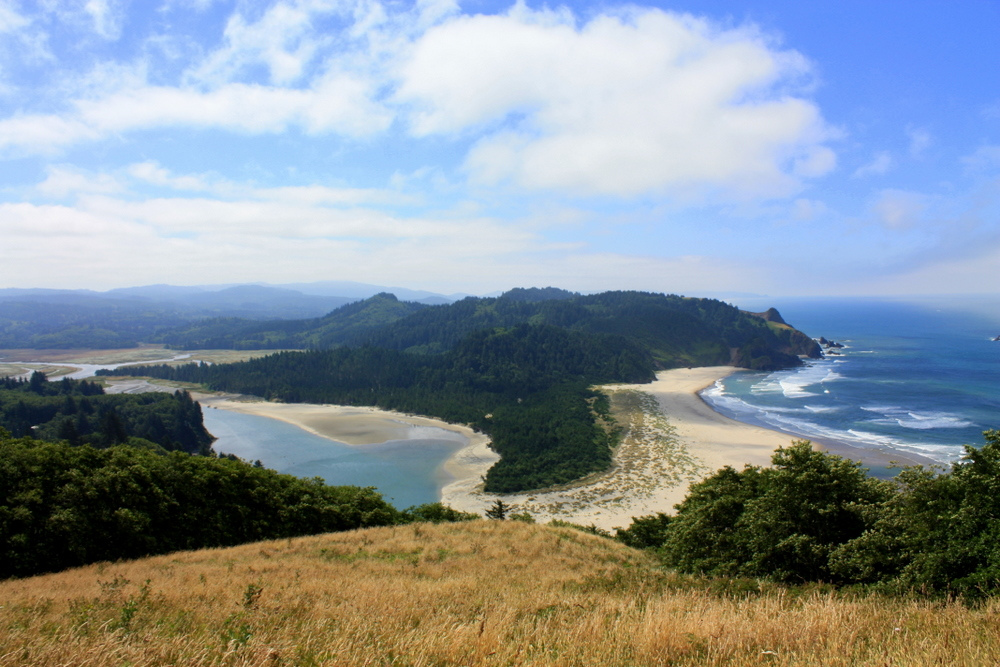
View along the Cascade Head Trail. Photo © Leslie Seaton, licensed Creative Commons Attribution.
About 10 miles north of Lincoln City, the 11,890-acre Cascade Head Experimental Forest was set aside in 1934 for scientific study of typical coastal Sitka spruce and western hemlock forests found along the Oregon coast. In 1974 Congress established the 9,670-acre Cascade Head Scenic Research Area, which includes the western half of the forest, several prairie headlands, and the Salmon River estuary. In 1980 the entire area was designated a biosphere reserve as part of the United Nations Biosphere Reserve system. Today, in addition to its biological importance, the area is a mecca for some 6,000 hikers annually and for anglers who target the salmon and steelhead runs on the Salmon River.The headlands, reaching as high as 1,800 feet, are unusual for their extensive prairies still dominated by native grasses: red fescue, wild rye, and Pacific reedgrass. The Nechesney Indians, who inhabited the area as long as 12,000 years ago, purposely burned forest tracts around Cascade Head probably to provide browse for deer and to reduce the possibility of larger uncontrollable blazes. These human-made alterations are complemented by the inherent dryness of south-facing slopes that receive increased exposure to the sun. In contrast to these grasslands, the northern part of the headland is the domain of giant spruces and firs because it catches the brunt of the heavy rainfalls and lingering fogs. Endemic wildflowers include coastal paintbrush, goldenrod, streambank lupine, rare hairy checkermallow, and blue violet, a plant critical to the survival of the Oregon silverspot butterfly, a threatened species found in only six locations. Deer, elk, coyotes, snowshoe hare, and the Pacific giant salamander find refuge here, while bald eagles, great horned owls, and peregrine falcons may be seen hunting above the grassy slopes. Today, in addition to its biological importance, the area is a mecca for some 6,000 hikers annually and for anglers who target the salmon and steelhead runs on the Salmon River.On the north side of the Salmon River, turn west from U.S. 101 onto Three Rocks Road for a scenic driving detour on the south side of Cascade Head. The paved road curves about 2.5 miles above the wetlands and widening channel of the Salmon River estuary, passes Savage Road, and ends at a parking area and boat launch at Knight County Park. From the park, the road turns to gravel and narrows (not suitable for RVs or trailers) and continues about another 0.5 mile to its end at a spectacular overlook across the estuary.
Cascade Head offers some outstanding scenic hikes, with rainforest pathways and wildflower meadows giving way to dramatic ocean views.
A short but brisk hike to the top of the headland on a Nature Conservancy trail begins near Knight County Park. Leave your car at the park and walk 0.5 mile up Savage Road to the trailhead. It’s 1.7 miles one-way, with a 1,100-foot elevation gain. No dogs or bicycles are allowed on the trail, which is open year-round.
Two trails are accessible from Cascade Head Road (Forest Rd. 1861), a gravel road that is open seasonally (July 16-Dec. 31) that heads west off U.S. 101 about three miles north of Three Rocks Road, near the highway summit of Cascade Head. Travel this road four miles west of U.S. 101 to the Hart’s Cove Trailhead. The first part of the trail runs through arching red alder treetops and 250-year-old Sitka spruces with five-foot diameters. The understory of mosses and ferns is nourished by 100-inch rainfalls. Next, the trail emerges into open grasslands. The five-mile round-trip hike loses 900 feet in elevation on its way to an oceanfront meadow overlooking Hart’s Cove, where the barking of sea lions might greet you. This trail can have plenty of mud, so boots are recommended as you tromp through the rainforest.
An easier trail accessible from Cascade Head Road heads to a viewpoint on the Nature Conservancy’s preserve. (Again, no dogs or bikes are allowed on Nature Conservancy land.) The one-mile trail starts about 3.5 miles west of U.S. 101 and heads to a big meadow and an ocean overlook. It’s possible to continue from the overlook, heading downhill to join up with the lower Nature Conservancy trail described above.
The Cascade Head Trail runs six miles roughly parallel to the highway, with a south trailhead near the intersection of Three Rocks Road and U.S. 101 and a north trailhead at Falls Creek, on U.S. 101 about one mile south of Neskowin. It passes through old-growth forest and is entirely inland, without the spectacular ocean views of other trails in the area.
The region in the shadow of Cascade Head can be explored in even greater depth thanks to the Sitka Center for Art and Ecology (56605 Sitka Dr., Otis, 541/994-5485, 8:30am-4:30pm Mon.-Fri.), located off Savage Road on the south side of the headland. Classes are offered June-August focusing on art and nature, with an emphasis on the strong relationship between the two. Experts in everything from local plant communities to Siletz Indian baskets conduct outdoor workshops on the grounds of Cascade Head Ranch. Classes can last from a couple of days to a week, and fees vary accordingly.